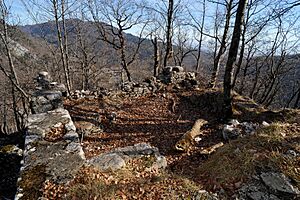Sauge facts for kids
Quick facts for kids
Sauge
|
||
|---|---|---|

Frinvillier village main street
|
||
|
||
| Country | Switzerland | |
| Canton | Bern | |
| District | Jura bernois | |
| Area | ||
| • Total | 13.46 km2 (5.20 sq mi) | |
| Population
(Dec 2020 )
|
||
| • Total | 827 | |
| • Density | 61.44/km2 (159.13/sq mi) | |
| Postal code |
2536-37
|
|
| Surrounded by | Orvin, Péry, Romont, Pieterlen, Biel/Bienne | |
Sauge (French pronunciation: [soʒ]) is a town, also called a municipality, in Switzerland. It is located in the Jura bernois area of the Bern region. This area is known as the French-speaking Bernese Jura. On January 1, 2014, two smaller towns, Plagne and Vauffelin, joined together to form the new municipality of Sauge.
Contents
History of Sauge
Plagne's Story
Plagne was first mentioned in old records in 1311. At that time, it was called Blenn. For a while, it was also known by its German name, Plentsch, but this name is no longer used today.
In 1311, Plagne was part of a land area controlled by the Basel Cathedral. This land was given to a person named Bourkard de La Roche. Later, it belonged to the Erguel area, which was ruled by the Prince-Bishop of Basel.
In 1797, after the French won a war, Plagne became part of France. It was first in the Mont-Terrible region, then in the Haut-Rhin region. After Napoleon lost power, Plagne became part of the Canton of Bern in Switzerland in 1815. In 1862, a big fire destroyed the center of the village. It had to be rebuilt over the next few years.
Long ago, people in Plagne worked in farming. Some also mined small amounts of metal or white clay. By the late 1700s, many residents started making parts for watches from their homes. In the 1970s, more people moved to Plagne. They often worked in the nearby city of Biel/Bienne and traveled from Plagne.
Vauffelin's Story
Vauffelin was first mentioned in records in 1228. It was sometimes called Füglistal or Füglisthal in German, but these names are not used anymore. The village of Frinvillier, which is part of Vauffelin, was first mentioned in 1393.
Frinvillier was an important place in ancient Roman times. It was located where two major Roman roads crossed. One road went from Petinesca (now Studen) to Augusta Raurica (near Augst). The other went from Eburodunum (now Yverdon) to Salodurum (Solothurn). A watchtower was built at Rondchâtel to guard these roads.
In 1364, the Count Thierstein gave the church in Vauffelin to the Church of St. Benedict in Biel. For many years, Vauffelin was part of the Erguel area, ruled by the Prince-Bishop of Basel. Like Plagne, Vauffelin became part of France in 1797. It was also in the Mont-Terrible and Haut-Rhin regions. After Napoleon's defeat, Vauffelin joined the Canton of Bern in 1815.
Vauffelin changed to the new Reformed Christian faith in 1530. At first, the pastor from Orvin helped the church in Vauffelin. Later, the pastor from Péry took over. In 1839, Vauffelin and Romont formed their own church area. The church building was built in 1715-16. It was repaired in 1932-34 and again in 1983. In 2010, Vauffelin joined a larger church area with Péry-La Heutte and Orvin.
In the 1970s, more people moved to Vauffelin. Many of them worked in Biel and traveled from the village. In 1971, the villages of Vauffelin, Romont, and Frinvillier created a shared school district.
Geography
The area of Sauge, including the former towns of Plagne and Vauffelin, covers about 13.44 square kilometers.
Population
As of December 2012, the total population of Sauge was 772 people.
Historic Population Trends
The chart below shows how the population of Plagne and Vauffelin changed over many years.

Cool Places to See
A beautiful natural area called the Taubenloch Canyon is partly in Sauge. This canyon is also shared with the towns of Biel/Bienne, Orvin, and Péry. It is a protected site because of its special natural beauty.
Getting Around (Transportation)
The Frinvillier-Taubenloch railway station is located on the edge of Sauge. This train station is on the line that connects Biel/Bienne and La Chaux-de-Fonds. Trains run every hour, making it easy to travel to Biel/Bienne, Moutier, and La Chaux-de-Fonds.
Images for kids
See also
 In Spanish: Sauge para niños
In Spanish: Sauge para niños








